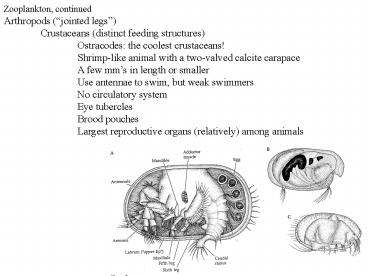Zooplankton, continued - PowerPoint PPT Presentation
1 / 10
Title:
Zooplankton, continued
Description:
Zooplankton, continued. Arthropods ('jointed legs') Crustaceans ... Shrimp-like animal with a two-valved calcite carapace. A few mm's in ... Arrow worms ... – PowerPoint PPT presentation
Number of Views:60
Avg rating:3.0/5.0
Title: Zooplankton, continued
1
Zooplankton, continued Arthropods (jointed
legs) Crustaceans (distinct feeding
structures) Ostracodes the coolest
crustaceans! Shrimp-like animal with a
two-valved calcite carapace A few mms in
length or smaller Use antennae to swim, but
weak swimmers No circulatory system Eye
tubercles Brood pouches Largest reproductive
organs (relatively) among animals
2
- Larger Zooplankton
- Copepods
- Crustaceans
- 0.5 to 10 mm
- Feed by creating eddies
Simple median eye (lacking in some)
Simple head shield
Frilly appendages to avoid sinking
6 thorax segments, 1 or 2 fused to head
5 abdomen segments telson
3
- Krill
- Crustaceans, related to shrimp
- Two eyes
- Tough organic carapace
- External gills
- 4 to 15 cms long
- Densities may exceed 1000 animals per cubic meter
- Important food for whales, squid, fish, and birds
- Human consumption?
4
- Arrow worms
- 0.5 to 12 cm
- Present at all water depths but very common at a
few hundred meters or less - Streamline, fins, some transparent
- Effective predator grasping spines and teeth
like a leg hold trap, have neurotoxins - Not efficient digestion waste products rich in
nutrients - Hermaphrodites
5
- Tunicates
- Chordates, but lack backbone (not vertebrates,
urochordates) - Larger ones, called salps, are between 1 and 15
cm in length - Smaller ones are less than 1 cm
- Swimming larvae
- Some build hollow gelatinous homes, transparent
- Can form dense mats on sea surface.
6
By-the-Wind-Sailor Man o War
Gas-filled floats
Hydra (hydrazoans)
- Cnidarians
- Include true jellyfish, hydra and corals.
Jellyfish and some hydra are plankton. - Include solitary and colonial forms.
- Alternating polyp and medusa generations. In
jellyfish, medusa stage dominant in hydra polyp
and medusa stage are about equal longevity. - Feed using nematocysts
Jellyfish (scyphozoans)
7
- Alternation of generation in the cnidarians
- Medusa stage (planktonic) is a product of asexual
reproduction (genetic material from one parent),
but it reproduces sexually. - Polyp stage (sessile benthic attached to the sea
floor) may be a product of sexual or asexual
reproduction, but it only reproduces asexually
How a nematocyst (stinging cell) works When the
cnidocil is bumped, a trap door (operculum) is
opened. It held back a tightly coiled stinger.
The stinger snaps. The stinger has barbs and
spines so that it stays in the victim. It also
contains toxins.
8
- Ctenophores (comb jellies)
- Live from the surface down to about 3 km of
depth. - Transparent, gelatinous body with neutral
buoyancy. - Cm to m in size.
- Predominant zooplankton in some areas
- Use ctenes (rows of cillia) to adjust position in
water column - Can eat cnidarians and ingest nematocysts without
causing nematocysts to fire. Nematocysts get
incorporated in ctenophores skin and are then
used for defense. - Predators. Tentacles have colloblasts (suction
cup that secretes sticky substance). - Simultaneous hermaphrodites (contain male and
female sex organs at the same time). Yup, they
can self-fertilize.
9
- Pteropods (sea butterflies)
- A strange group of snails in which the foot
(parapoda) has been modified into a sail or
parachute like device. - Many have calcareous shells.
- Foot covered with sticky mucus--useful in
capturing zooplankton
10
- Meroplankton
- These are organisms that are planktonic for only
part of their lives. - The other plankton that we have been discussing
are holoplankton (plankton for entire life)






























